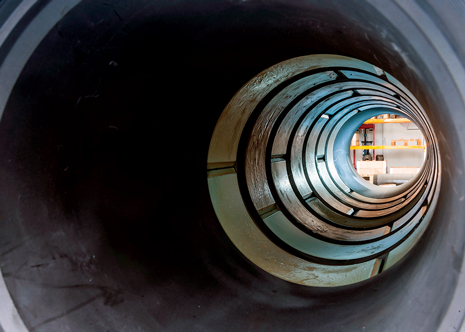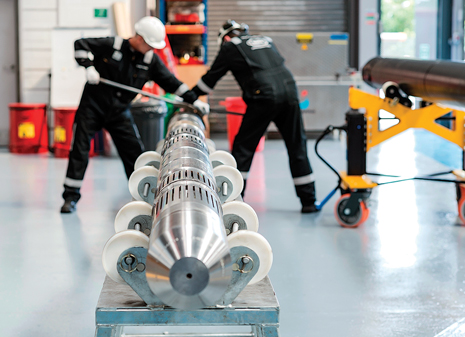 |
| Fig. 1. The Meta liner tieback achieves greater durability and permanence in deepwater operations than do other technologies. |
|
Well integrity is one of the biggest issues facing the offshore oil and gas sector. This challenge was made apparent by a study, conducted on a number of wells on the Norwegian Continental Shelf, by Norway’s Petroleum Safety Authority (PSA); it found that every fifth well analyzed had well integrity weaknesses.
While some countries, still allow a certain amount of self-regulation, operators in some offshore regions—such as the North Sea and the Gulf of Mexico—are subject to increasingly strict well management requirements from organizations, such as PSA, and, in the U.S., the Bureau of Safety and Environmental Enforcement (BSEE).
These regulatory requirements are increasing the onus on operators to establish structural integrity and contingencies at the planning stage; recomplete existing producing wells to comply with new legislation; ensure that well integrity is not compromised by trouble zones and stuck casing; and reinstate well integrity quickly, when damage does occur.
Both regulators and operators, alike, are pushing for high-quality well architectures, along with strong structural and casing integrity.
According to Morgan Stanley, some 27 MMbpd of new oil production needs to come onstream over the next seven years, to meet rising energy demand. Maximizing production, and tapping into new offshore oil and gas frontier regions, has never been more important. Increased regulatory scrutiny and a focus on well integrity has, however, led to an urgent need to strike a balance between reducing risk in well operations, on one side, and increasing production and well profitability, on the other.
Despite the growing importance of well integrity—particularly since Macondo—questions still remain as to its role in a well’s life cycle. What, exactly, is well integrity, and when does it start in a well’s life cycle? Is it possible to protect well integrity, and at what stage? And how can well integrity be protected safely and effectively, while maximizing production?
While there are clearly many innovative well integrity technologies on the market today, more needs to be done to establish structural and casing integrity at the outset; plan for well integrity across the lifecycle of a well; and overcome existing technological weaknesses.
One technology and method that is providing disruptive change, in this area, is Metalmorphology. Patented by Meta, Metalmorphology uses established metal-working principles to shape metal downhole, with control and precision, to deliver a gas-tight, durable metal-to-metal seal.
This technology balances the mechanical strength of steel with elastic properties to create isolation solutions that instantly morph together, to provide 100% conformance within the wellbore or casing. Today, Metalmorphology provides a morphing ratio up to 60%, an axial load-bearing rating up to 6 million lb and a sealing rating of up to 15,000 psi.
The result is a gas-tight, axial load-bearing, metal-to-metal sealing solution, which conforms to current well integrity legislation. It also gives operators confidence in their isolation and well-integrity solutions.
WELL ARCHITECTURE IN THE NORTH SEA
Using Metalmorphology, the Meta liner tieback, and its metal-to-metal morphing technology, is a key means of demonstrating this compliance. By morphing metal, it connects the liner to a tieback receptacle built into the previously run casing string. The result is a fully compliant, V0 ISO14310 certified metal-to-metal connection, with no reduction in internal diameter (ID) and no reliance on elastomers; it is capable of offering full integrity for the lifetime of a well.
The durability of the metal-to-metal seal enables the liner tieback to operate at pressures of up to 13,500 psi, at temperatures of 320°F, and with an axial load-bearing capability of up to 6 million lb, making it ideal for deepwater challenges.
The Meta liner tieback is designed to achieve greater durability and permanence in deepwater operations than other technologies—especially elastomeric-based solutions that are perishable and sometimes only last up to 6 months in V0 deepwater conditions.
Besides compliance, there are other benefits. The solution removes the time-consuming, space-out process. It can be installed in one day, as compared to the more typical five, or more, days—this saves costly rig time and an estimated minimum of $3 million.
The liner tieback was installed recently by a North Sea operator as part of a highly-complex field expansion project, with ambitions to double output. The field came with drilling and well architecture challenges that were preventing completions. One particular challenge was equivalent circulating density (ECD), which can lead to wellbore instability. The operator needed a strong liner tieback interface, with no reduction in ID, and the ability to avoid tying liners back to the surface for as long as possible.
The liner tieback was installed on a 95/8-in. liner, allowing the operator to drill multiple sections below, while keeping the 135/8-in. casing above the liner open for as long as possible.
Meta successfully ran the liner tieback to a depth of 3,000 m. It was deployed through a 65° build section and successfully set in 15-ppg oil-based muds and at 70°C. The result was a life-of-well, gas-tight connection that has extended the envelope for well construction and will deliver tieback integrity over the lifetime of the well.
As a result, the operator benefitted from improved well control; reduced rig costs and non-productive time; faster drilling and earlier revenue; and profitable and productive wells for the life of the field.
 |
| Fig. 2. Metalmorphology uses metal working principles to shape metal downhole, to create a gas-tight, durable metal-to-metal seal. |
|
REGULATORY DEMANDS
Operators in the Gulf of Mexico face strict scrutiny of their wells, with BSEE requesting additional information on well planning activities, in the form of a new worst-case discharge criterion that is particularly applicable in deepwater wells. All assumptions made regarding well design, estimated flowrates, the maximum duration of potential uncontrolled flow, and the total volume, must be considered
by operators.
This has made it necessary for operators to alter their well designs and strengthen their well architectures—particularly at the earlier well life cycle stage—to adhere to these regulations.
A series of Meta tieback systems are due to be installed, by Shell, in a deepwater field in the Gulf of Mexico. The operating temperature will be 120°C and, once the tieback is installed, the deployment depth will be 10,000 ft. Hydrostatic pressure at this depth will be 3,750 psi to 5,800 psi, depending on fluid in the well.
Through the incorporation of the liner tieback into its well architecture, Shell will ensure that it remains fully compliant with current regulations; overcomes limited IDs in casing strings to achieve high load-bearing capabilities; allows asset teams to plan for drilling deeper; and provides flexibility of space out.
REDEFINING WELL INTEGRITY
For too long, well integrity has been defined by a reactive approach, and the limitations of current well planning and intervention technologies.
Metalmorphology is providing a new way of working, which redefines well integrity and delivers reliability and long-term durability in offshore well architecture.
It is through incorporation of the liner tieback into well architectures, in some of the world’s most complex fields, that structural integrity can be assured. Drilling can go deeper with no restrictions on load-bearing capabilities; intervention and risk can be avoided; and future EOR plans are embedded.
The results for offshore operators are reduced risk; improved casing and structural integrity; the protection and maximization of future production; and more profitable and productive wells. 
|




